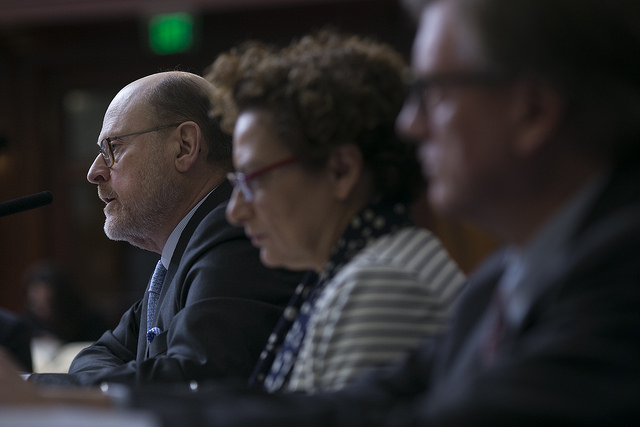Forget about Governor Cuomo's "subway action plan" for a moment and consider what the MTA and NYC DOT need to do to turn around cratering bus service.
Ridership on the MTA's buses dropped 6 percent in 2017, accelerating a long-term downward trend, and transit advocates have a point-by-point plan to speed up service and win back riders. Getting the MTA and DOT on board has taken some wrangling, but there were signs of progress today.
This morning transit advocates rallied with council members Carlos Menchaca and Ydanis Rodriguez at City Hall, calling for the de Blasio administration to budget for more bus lanes, signal priority for buses, and real-time arrival displays at bus stops.
"Local bus service is the lifeblood of our city, and the lack of reliability, the constant delays, happens on a daily basis," Menchaca said. "We're going to need the mayor's forceful actions to make this better."
During the City Council hearings that followed, MTA officials made a plausible show of adopting key recommendations from the Bus Turnaround Coalition. The de Blasio administration was less convincing.
The alarming drop in bus ridership has spurred the MTA to at least promise action: Last month, MTA bus chief Darryl Irick announced the intent to take "bold radical steps" to turn around bus service, promising a "bus action plan" in the spring.
Inside City Hall today, Rodriguez pressed MTA Chair Joe Lhota on the details of the bus strategy. Lhota said that it would be developed in cooperation with the city and address both inefficiencies in bus routing and traffic congestion that slows down buses. He also said he agreed with "the folks who were outside" that citywide all-door boarding should accompany the MTA's new fare payment system, which will launch next year.
Lhota cited the MTA's redesign of the Staten Island express bus network as a potential model for the rest of the city. The agency revealed the final version of the Staten Island bus overhaul yesterday.
As housing and employment patterns shift, Lhota acknowledged that the MTA's bus routes haven't kept up. "The demographics of the city of New York are changing quicker than ever before in history. People are moving into what used to be warehouse districts," he said. "We have to evaluate our routes."
In terms of congestion, Lhota said that beyond congestion pricing, the state legislature should expand the city's automated enforcement of bus lanes.
That was welcome news to DOT Commissioner Polly Trottenberg, who testified at a separate hearing in the afternoon. Pointing out that current law limits the city to enforcing 16 bus routes with cameras, Trottenberg said expanding the use of automated bus lane enforcement is "a key fundamental thing."
Trottenberg didn't say, however, that DOT would accelerate its implementation of bus lanes. Currently the city plans to roll out bus lanes on about two routes per year. Given the citywide decline in bus service, advocates want to ramp that up to around 10 routes per year.
In written testimony, Trottenberg did say that DOT plans to "quadruple" the pace of installing transit signal priority, which holds green lights and shortens red lights for buses. It's not clear what baseline she was referring to, however. The city had previously said it plans to add signal priority to five routes each year through 2020, and accelerating to 20 routes per year would be a major improvement. We have a request in with DOT to clarify.






